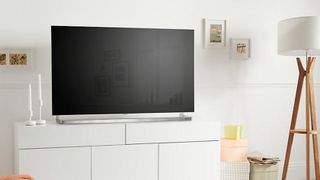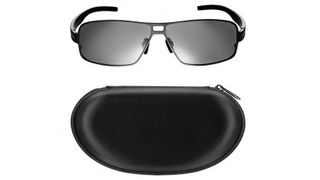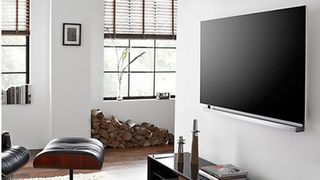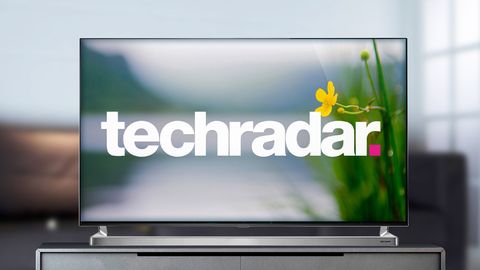TechRadar Verdict
The 55JL9000's combination of a gorgeous design, audio innovation in the form of a built-in sound bar, excellent feature count, ground-breaking webOS-driven smart TV interface and colourful, bold pictures ultimately do John Lewis proud.
Pros
- +
Gorgeous metallic design
- +
Innovative sound bar integration
- +
Colourful, bright pictures
- +
Groundbreaking smart TV interface
Cons
- -
Uninspiring contrast performance
- -
Not the cheapest TV
- -
Requires care with setup
- -
High input lag
Why you can trust TechRadar
Having successfully introduced its branding to other electronics products, predominantly in the white goods arena, it makes perfect sense for respected retailer John Lewis to turn its attention to big-screen TVs.
However successful John Lewis might be as a retailer, though, it isn't in a position to suddenly start building TVs from scratch. So it's had to turn to an established manufacturer for its big own-name TV debut, the 55-inch John Lewis 55JL9000. And that manufacturer is… [drum roll please] … LG Electronics.
As soon as you lay your eyes on the 55JL9000 it's easy to understand why John Lewis turned to the Korean manufacturer. It's one of the prettiest TVs I've seen – which is saying something when you think of the startling high glamour level of the general TV world these days.
Its metallic bezel is stunningly slim, distracting hardly at all from the images contained within it, and the super-slim screen is perched handsomely atop a striking, open-framed aluminium stand.

Connections
The 55JL9000 follows other LG TVs in providing a comprehensive suite of connections too, including four HDMIs, three USBs and both LAN and Wi-Fi network options.
Perhaps best of all, though, the 55JL9000's LG roots mean it carries the inspired new Smart+ TV interface, driven brilliantly by webOS software.
This interface completely revolutionises the Smart TV space with its sublimely intuitive design, which combines bold, colourful, graphics-rich icons with a super-slick, super-fast and super-intuitive navigation system. It also exhibits a groundbreaking understanding of what key features most consumers actually want a Smart TV to deliver.
For instance, the interface sensibly prioritises video content ahead of multimedia sources (though its multimedia support is certainly extensive), and provides inviting amounts of content link options on screen at once, without making things feel overcrowded or confusing. There are also lots of little animations as you navigate the menus to help you track where you are and reward you for your efforts.
Every source is equal
Best of all, the webOS system treats every possible content source – even each separate HDMI port – as its own app, so it's possible to multi-task and switch directly between all different types of content seamlessly.
The only problem with Smart+ TV is that it doesn't carry a full suite of UK catch up TV services, with the ITV Player and 4OD being conspicuously absent. Though LG does carry Now TV support while other platforms do not, and the key Netflix and Amazon Instant apps are also both available.
Moving beyond the 55JL9000's smart features, it transpires that the 55JL9000 sits above any of LG's own-branded HD sets in picture specification terms, revealing that John Lewis is clearly intent on associating its name with the premium, uncompromising end of the TV marketplace.
Picture features
Among its most important picture-related features are a contrast-boosting local dimming system for its LED lighting array, an impressively powerful motion compensation system, and a picture engine driven by a dual-core processor.
There's almost limitless control within the 55JL9000's menus over almost all aspects of its image processing and other picture technologies. So it comes as little surprise to find that the TV has bagged the endorsement of the Imaging Science Foundation (ISF) pro-calibration group.
The set also supports 3D playback using the passive system, with two rather swanky looking pairs of John Lewis-branded 3D glasses provided free. Last but not least it uses one of LG's IPS-type panels, designed to deliver a slightly wider effective viewing angle – at least with bright content – than rival panel technologies.

I'm duty bound to conclude this section by pointing out that the 55JL9000 is 'only' an HD TV rather than a 4K/UHD one. This could be seen as a problem when you think that you can get 55-inch 4K TVs for around £1500 these days, but personally I'd argue that there's still (for this year, at least) room for a really high quality premium HD TV – so long as it delivers on the performance and features.
Audio features
Normally I wouldn't have much to say about a typical flat TV's sound system, but the 55JL9000 is a worthy exception. Squeezed cunningly into the front horizontal bar of that striking aluminium desktop stand is a set of speakers.

Putting them in here has enabled LG to have them fire forward (rather than down like most flat TV speakers do) for a potentially punchier, clearer sound. Their power level is rated at a startling 50W when added to the output of a rear-mounted bass woofer.
If you're wondering what you do for sound if you want to wall mount the TV fear not; the TV ships with brackets that allow the speaker bar to rotate back and down so that it can sit directly under the TV on your wall. This is much more elegant in the flesh than it sounds on paper!
John has been writing about home entertainment technology for more than two decades - an especially impressive feat considering he still claims to only be 35 years old (yeah, right). In that time he’s reviewed hundreds if not thousands of TVs, projectors and speakers, and spent frankly far too long sitting by himself in a dark room.


